Shortly after Christmas, I was able to replenish some of my depleted goldwork supplies. I like 2% gold threads, and after making my goldwork and silk Christmas ornament and working on the goldwork embellished crazy quilt square, I found that I was low on 2% gold threads. With plans for a bit of ecclesiastical embroidery this year, I wanted to stock up on some (yeah, yeah – excuses! excuses!!)… Anyway, when placing my order with Tanja Berlin (which is where I buy my 2% gold threads), I purchased a couple “new” metal threads – new to me, anyway. Read on, and I’ll tell you about one very attractive gold thread with a really unattractive name!
I’ve been curious about “flatworm” for a while. Admittedly, it’s the name that caught my eye in the first place. Imagine being in the company of gold threads with names like “pearl purl” – names that evoke notions of beauty and richness – and having to own up to a name like “flatworm.”
“I’d like to buy some flatworm, please…” (Bait shopping?!)
“Hey, I want to embroider something beautiful. I think I’ll use flatworm.” !!!
The name is curious. Once I saw the thread, though, I realized it’s just a name. A rose by any other name would smell as sweet, and I suppose a gold thread named “flatworm” can still be … a gold thread.
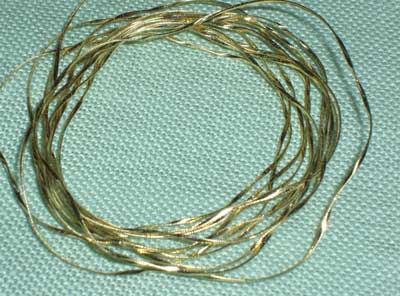
This is 2 yards of gilt #6 flatworm. Pretty, isn’t it? It shines!
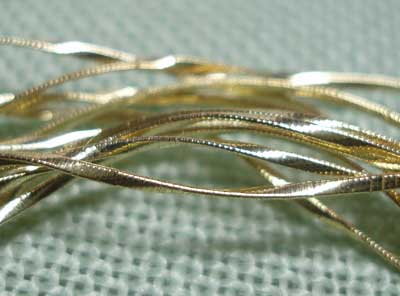
If you look at the thread close-up, the thread looks as if it is made just like smooth passing thread – it has a core of thread, around which is wrapped the gold thread. This is gilt, so it’s only about 1/2% gold (as opposed to 2%). Unlike smooth passing thread, which is rounded, flatworm is flat, but it has a kind of gradual twist in it – it isn’t like broad or whipped plate, either, which is completely flat, without a thread core, and is more like a metal ribbon.
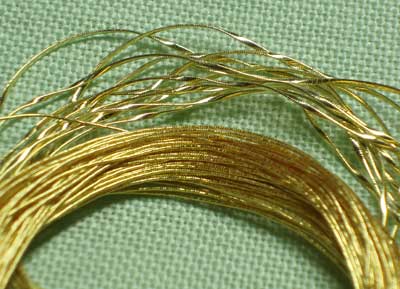
Here, you can see the gilt flatworm (in the background) and #4 smooth passing thread (2% gold – which has a higher content, and a deeper color).
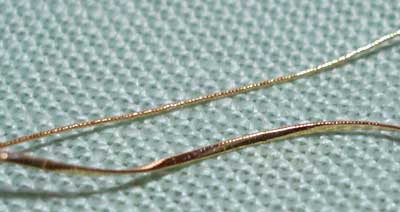
Next to each other, the threads are decidedly different. The #4 passing thread looks tiny. The flatworm looks almost leather-like and supple, as opposed to wire-like look of the smooth passing. The flatwork isn’t really supple, though – it’s stiffish, too. Perhaps not as stiff as the smooth passing, but pretty stiff, nonetheless.
I haven’t worked with flatworm before. From what I’ve read about it, it’s a couched thread, like smooth passing, but I’m curious about the way one would couch it. Can it be couched as a filling, in lines? Do you straighten it as you couch it? If not, how well does it sit on the fabric and actually “fill”? Is it used as a more randomly worked thread? Does it fit in with traditional goldwork techniques, or would you take a more contemporary approach to the way it is used? These are the questions that have come to my mind about this thread. I’ll enjoy experimenting with it to discover some of the answers.
Have you ever used flatworm? Or have you seen it on any goldwork pieces? Do you have any ideas about how you would use it if you were going to play with it? I’d like to hear your take on this intriguing thread!
There were a few other new-to-me threads in my recent order – I can’t wait to show them all to you! I’d rather be showing them to you in some kind of goldwork piece that could employ all of them, but my brain hasn’t yet concocted a reasonable plan for one! When it does, I’ll let you know!
If you haven’t signed up for my January give-away, please take the opportunity to do so before tomorrow (Wednesday) morning at 5:00 am CST. I’ll pick a winner first thing tomorrow morning! If you want to sign up, visit the original post, where you’ll find the directions for signing up towards the end of the post. Thanks for participating in it!
If you want to make sure you don’t miss anything on Needle ‘n Thread, you might take the opportunity to sign up for my e-mail newsletter. Just enter your e-mail in the box provided in the right hand column, and the newsletter will be delivered to your inbox daily. You’ll need to verify your subscription, so keep an eye out for the verification e-mail. I don’t use e-mail addresses for anything else except the e-mail newsletter, I assure you! Keep in mind that the daily newsletter you receive features the article from the previous day.
If you have a feedreader, you can sign up for my RSS feed if you prefer. You’ll get the latest news from Needle ‘n Thread on the day that it’s posted!
Hope your week’s going well so far, and that you have at least a little time to enjoy some stitching!




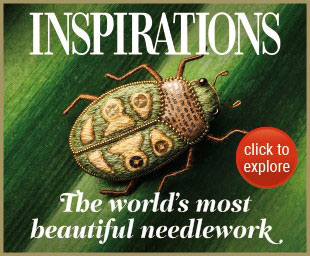

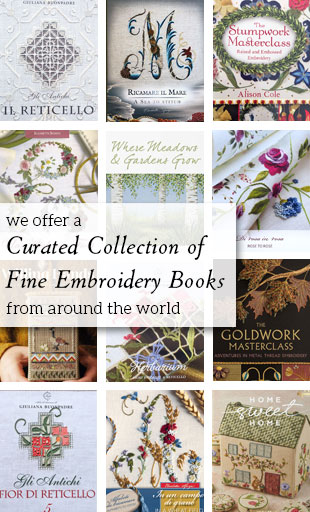
How to use flatworm, perhaps…
I found this on Wikipedia:
Flat Worm or simply Oval thread is a thin plate wrapped around a yarn core and flattened slightly. This is used like plate, but is considerably easier to work with.
Mary, can’t wait to see what you do with “flatworm”. What a yukky name for a glorious thread.
However, your mention of Tanja Berlin inspired me to get her a “shout out”. I have ordered several of her kits over the past couple of years. Her instructions are detailed and easy to follow, her kits are impeccable, and she is extremely generous with supplies. There is plenty for screw-ups and then enough leftover for experimentation. She is a real pro — and a great resource for anyone interested in these gentle arts — no matter your level. She is also helpful, but encouraging, in critiquing work.
Cissie